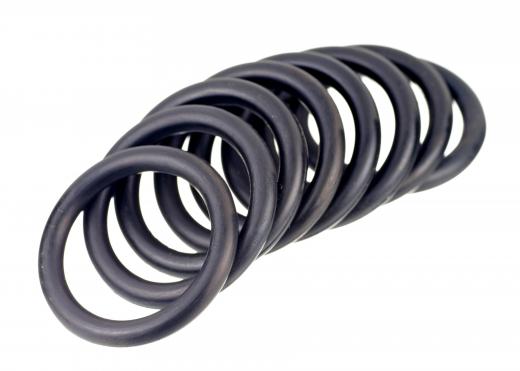A flanged fitting is a type of connection used to join two or more pipes. Each of the pipes must be equipped with a flange, or raised ridge that runs around the pipe's outside perimeter. Installers connect the two flanges via compression using bolts, clamps, or other fasteners. A flanged fitting may be used in place of traditional threaded connectors, welding, or soldering. Some types of flanges are used in conjunction with welding or soldering to create a stronger pipe joint.
Different types of flanged fittings can be distinguished by their function or design. Fittings used on very large pipes or gas lines other feature a flange with a smooth face and a series of pre-cut holes in the flange. When two of these flanged fittings are joined together, bolts are inserted into the holes in the flanges to create a strong, durable connection. A flanged fitting with a tapered neck may be used in high pressure applications. This type of connection generally requires both welding and bolting to withstand the extreme pressure of the materials within the pipe.

Installers who need to add a flanged fitting in the field can choose a threaded fitting, which features internal threads like those found at the ends of most pipes. This allows the installer to simply screw the fitting onto the pipe to fasten it in place. A threaded fitting makes it easy for workers to cut pipes to any size as needed for quick repairs, then create threads on the end using a pipe threader in order to accommodate the flange.
Flanged fittings may have a variety of profiles, depending on how they will be used. Elbow fittings feature a curved design to join two pipes at an angle, with a flange at either end for a more secure connection. A tee-shaped flanged fitting joins two pipes in a single run with another pipe running perpendicular, while a Y-fitting joins three pipes running at three angles. Some flanged fittings may even feature a four-way or cross-shaped design to accommodate four separate pipes.
Many flanged fittings are used in conjunction with special gaskets that help to prevent leaks at the joint between the two pipes. These gaskets are made of rubber or synthetic materials, and are often referred to as "o-rings." When flanged fittings are built to very specific tolerances, and the face of the flange is very smooth, installers may be able to avoid using a gasket to prevent leaks. In some applications, grease or lubricant can be applied in place of an o-ring to help seal any gaps between the flanges.
